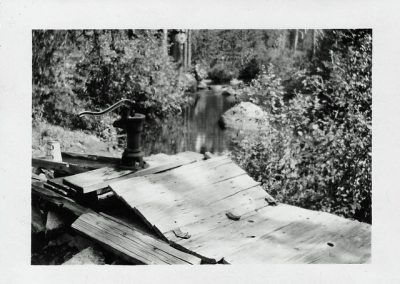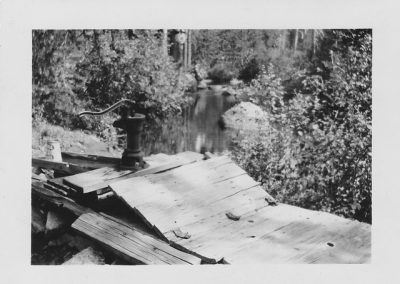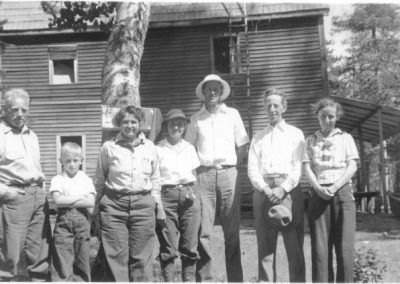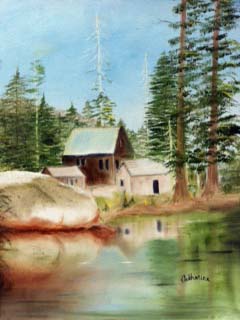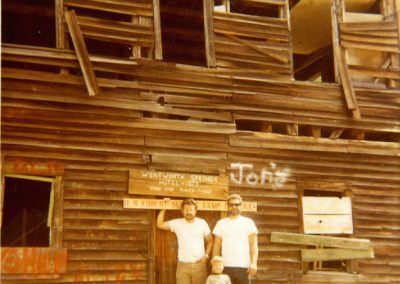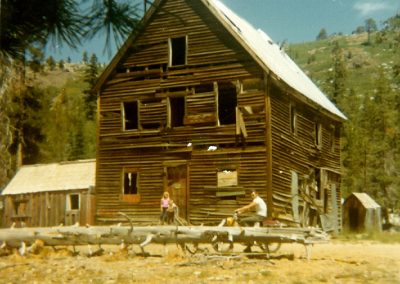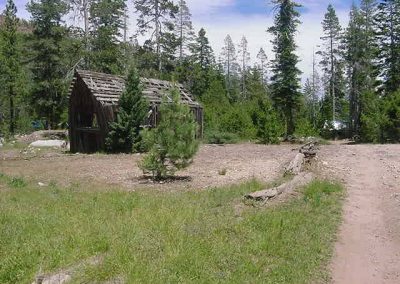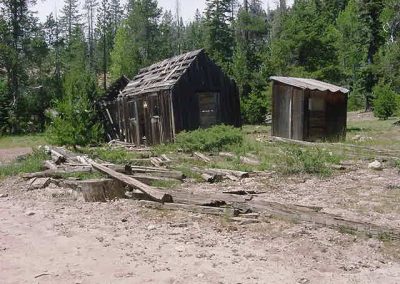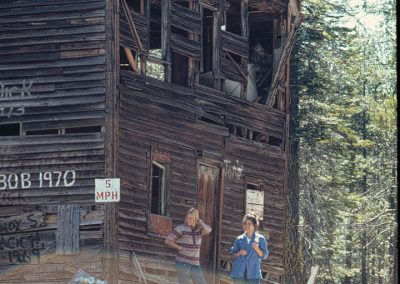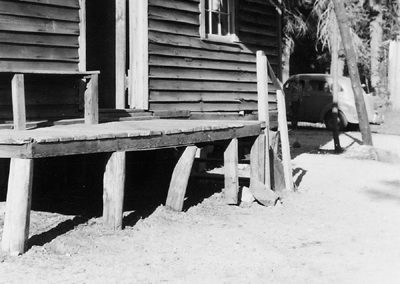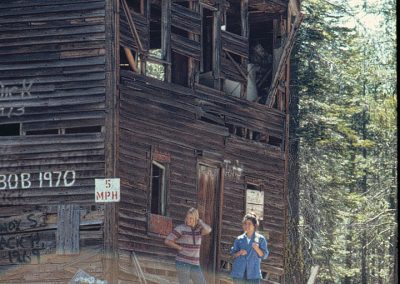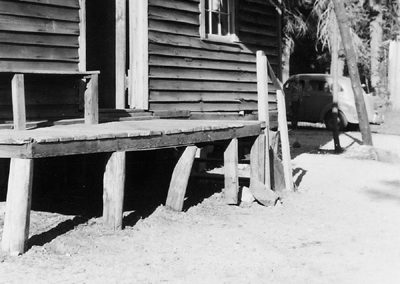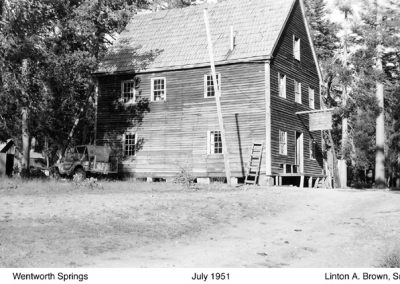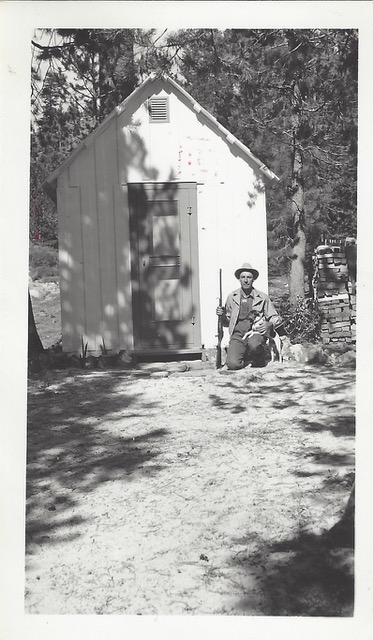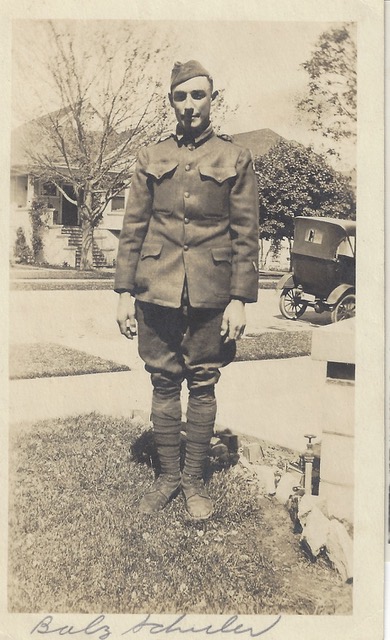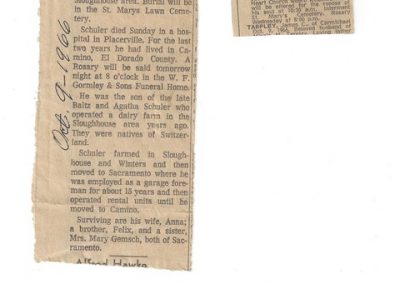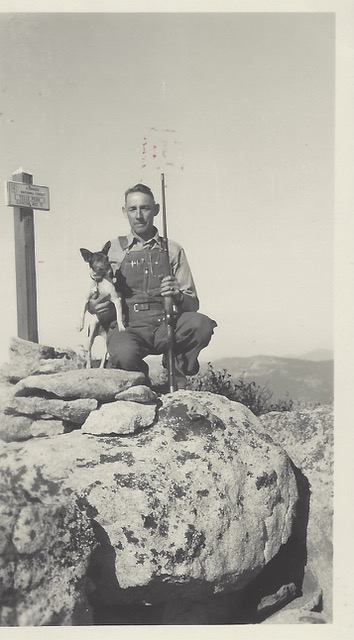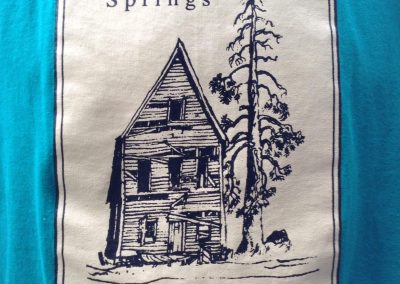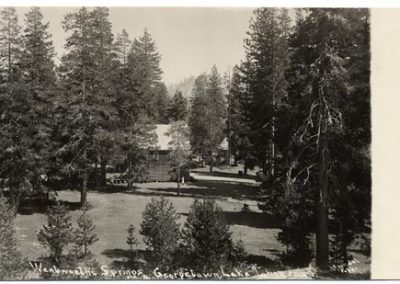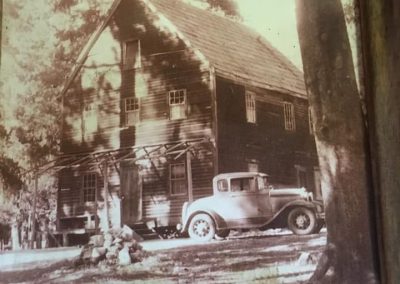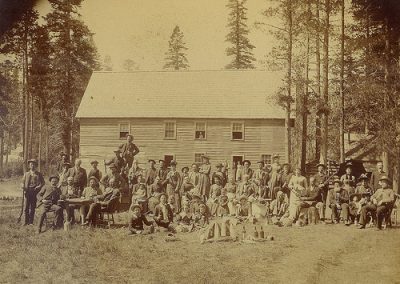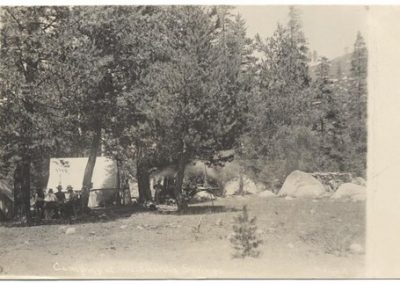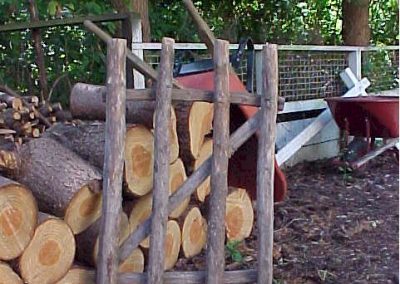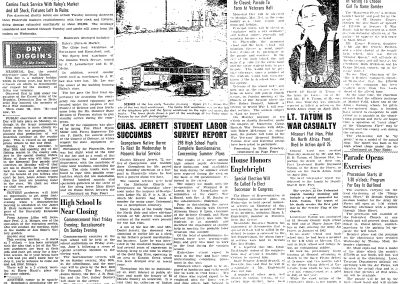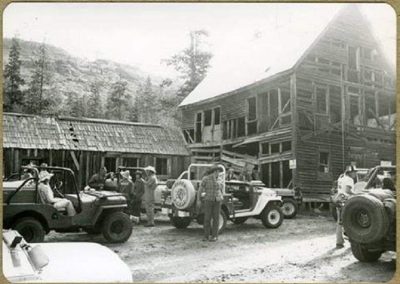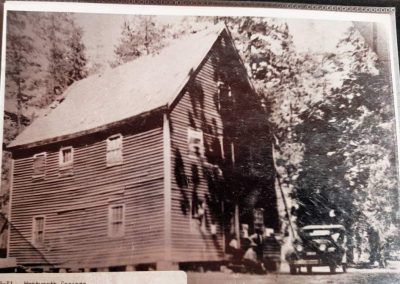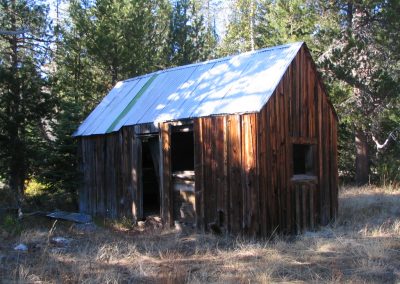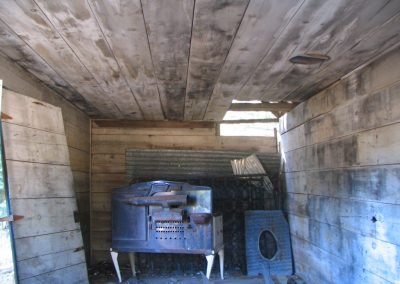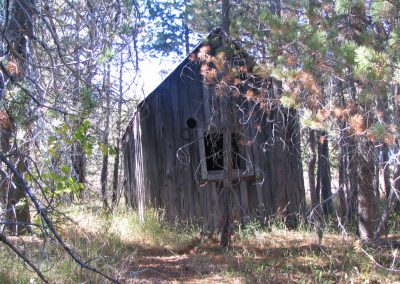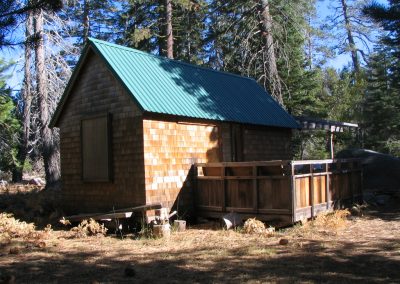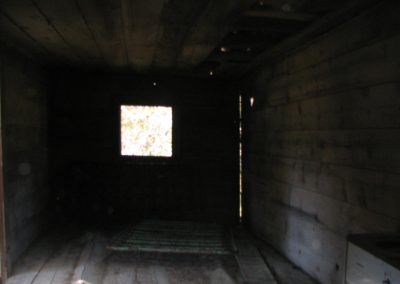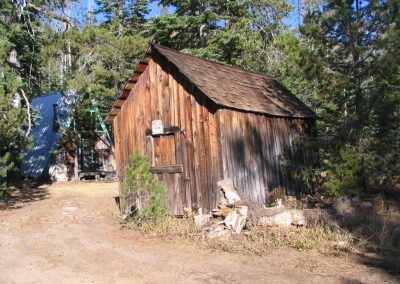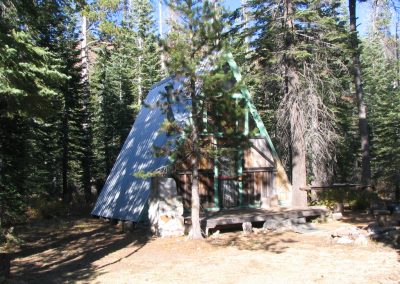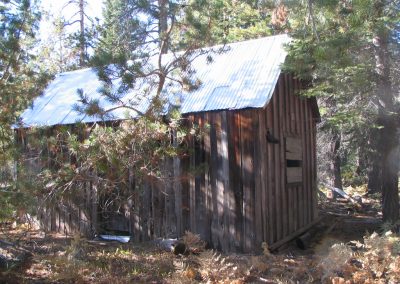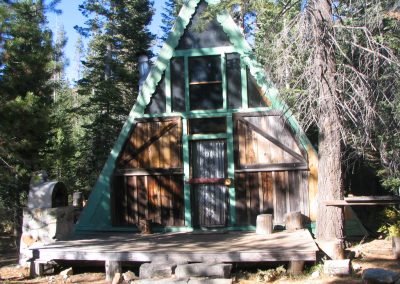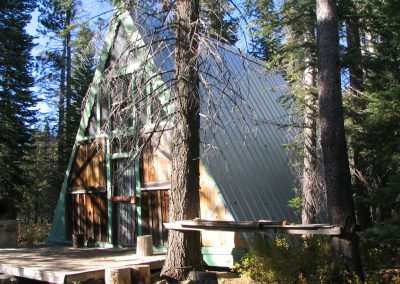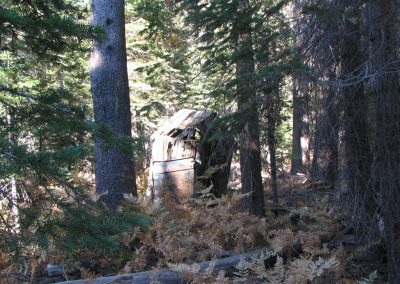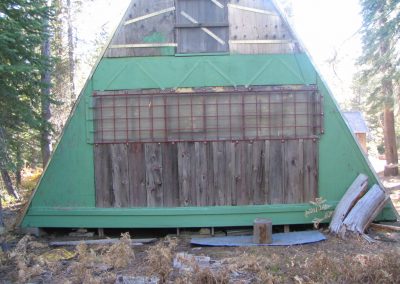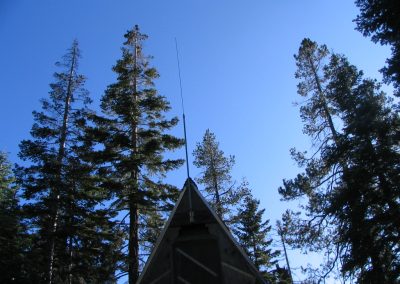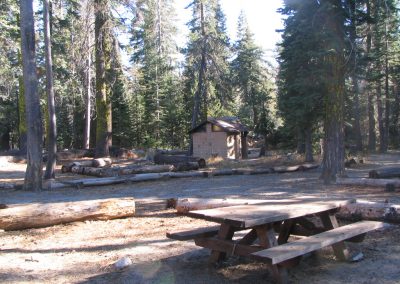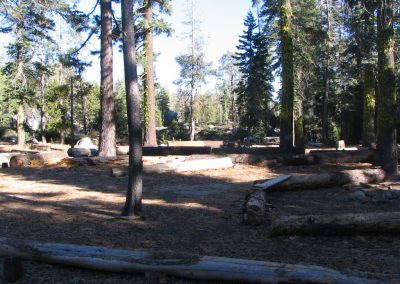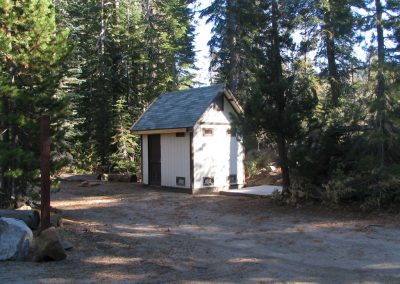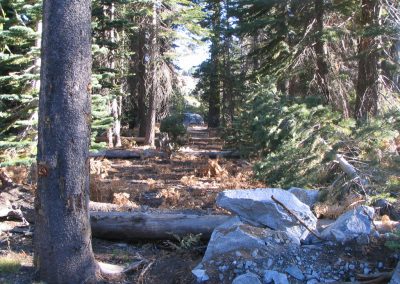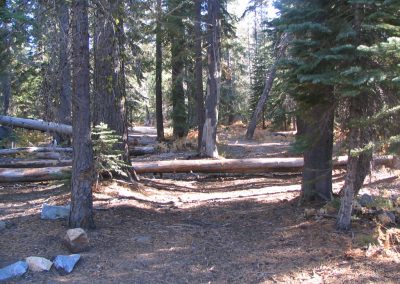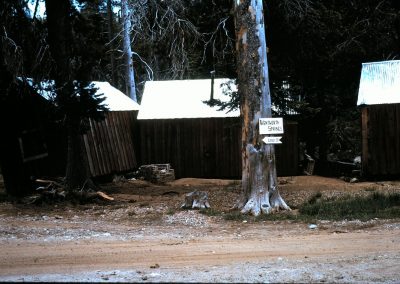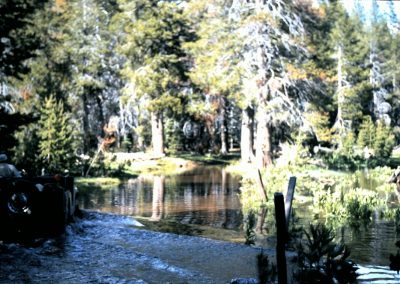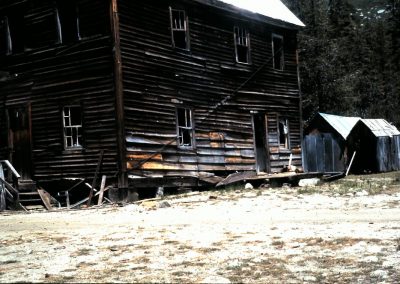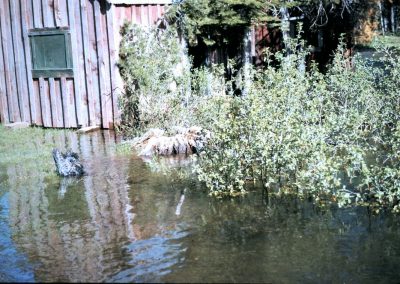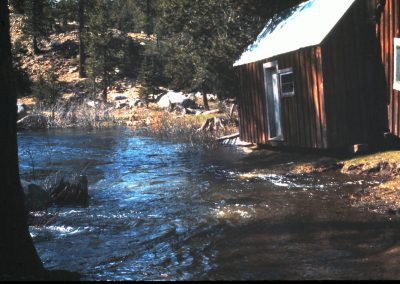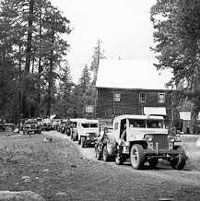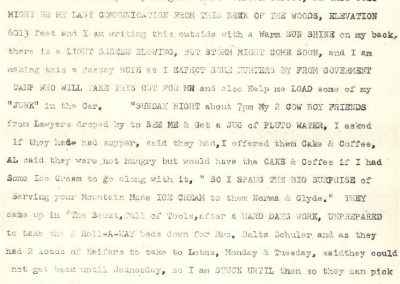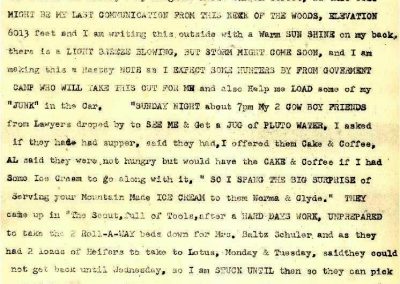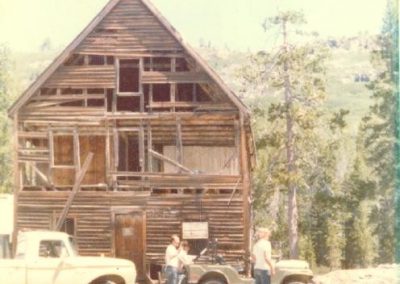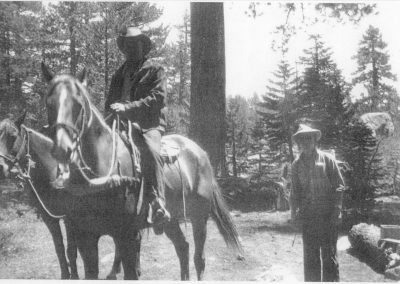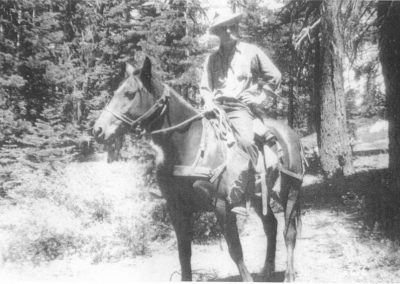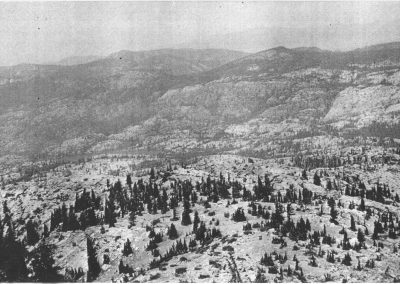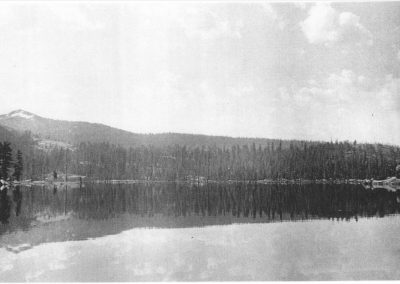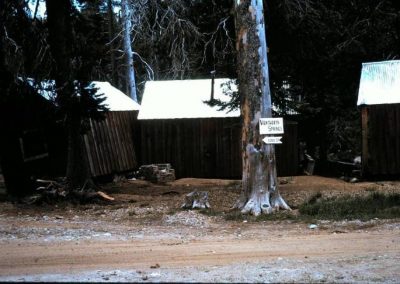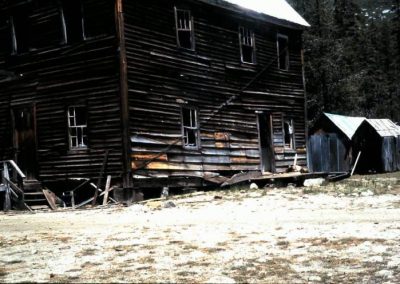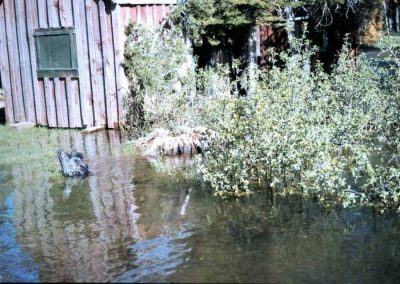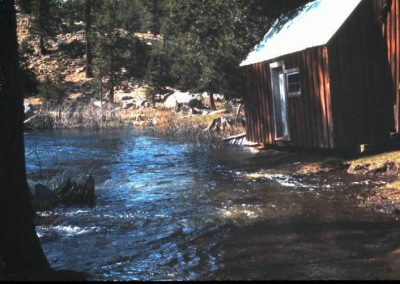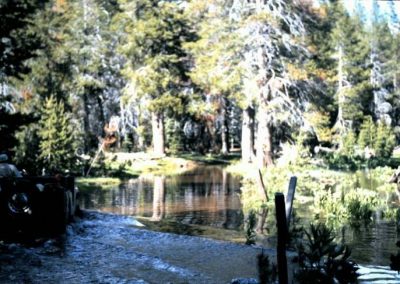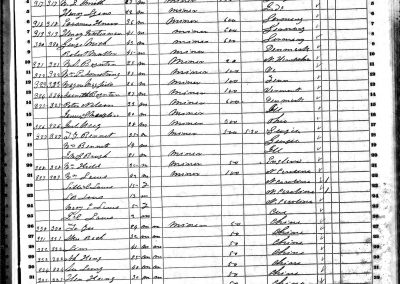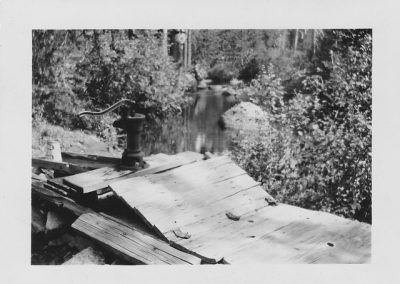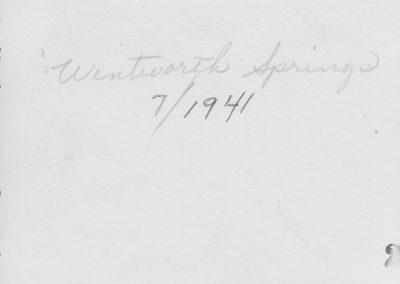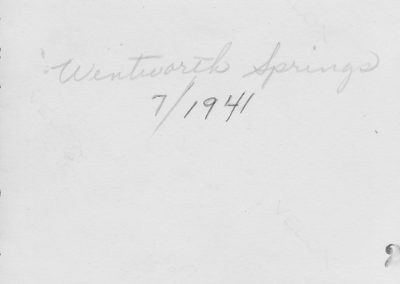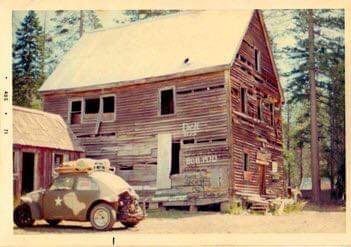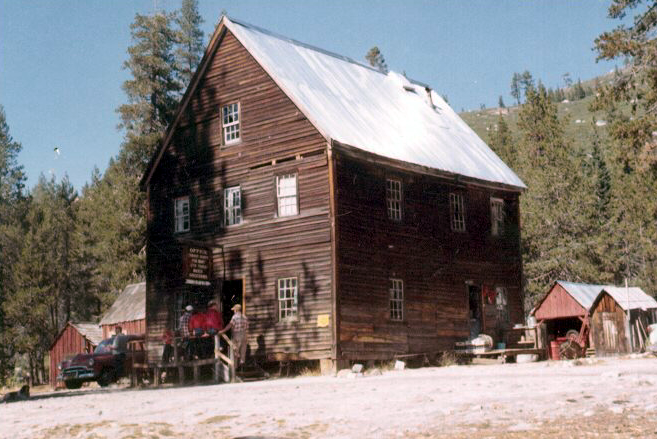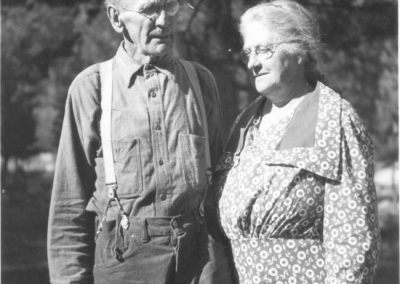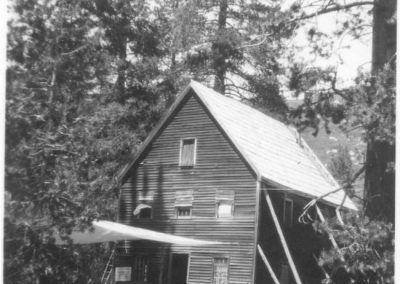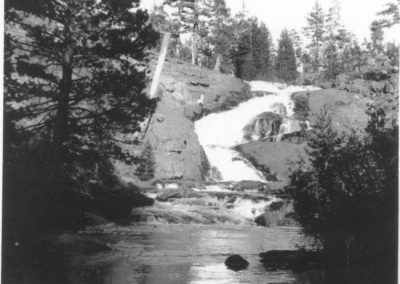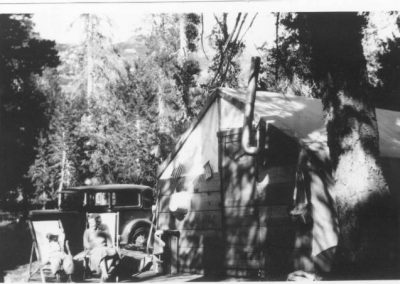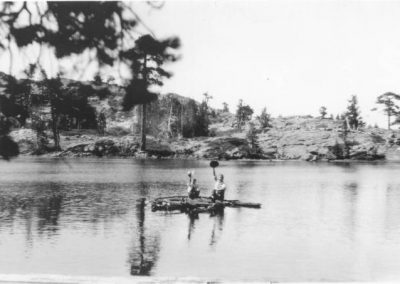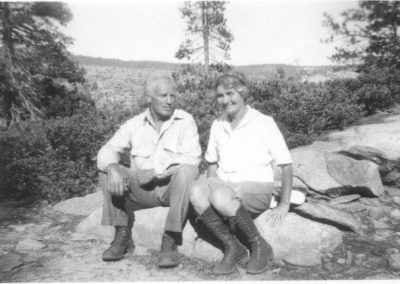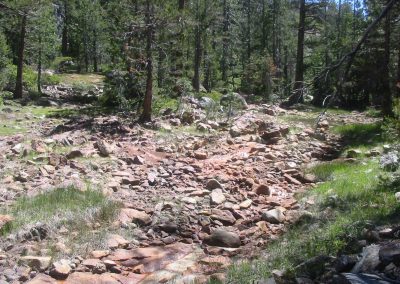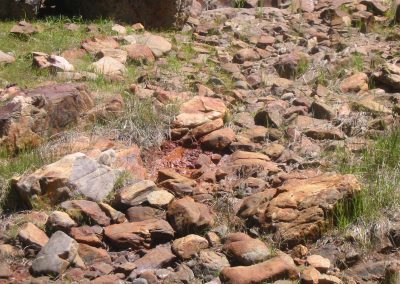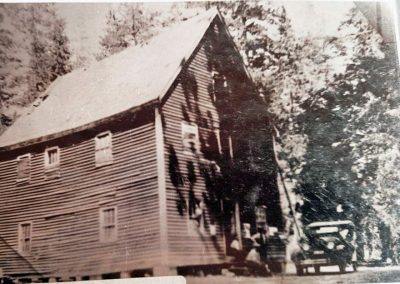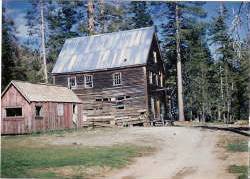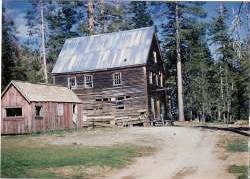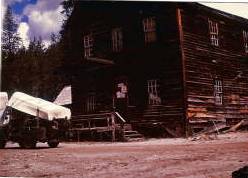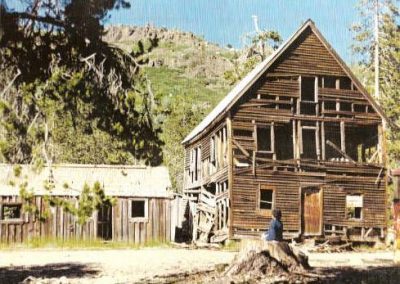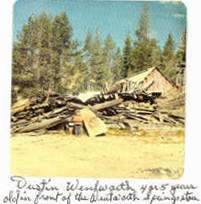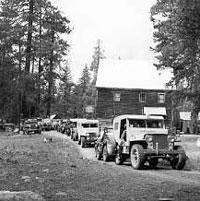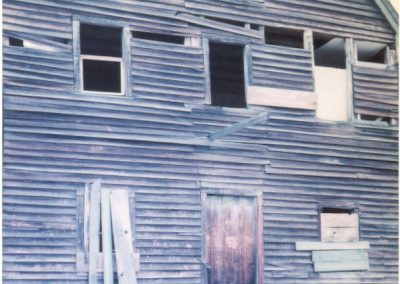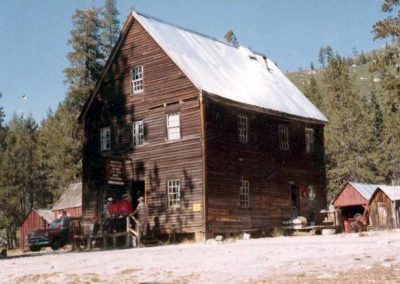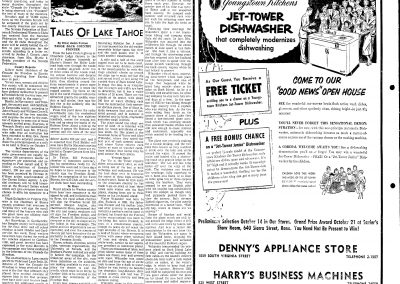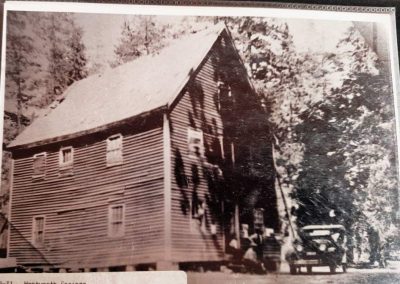WENTWORTH SPRINGS, CALIFORNIA
Wentworth Springs-1930-Gerle Creek
Wentworth Springs, California
Wentworth Springs-1880,Eldorado National Forest, El Dorado County, Ca
Wiklander Buck Island Lake Cabin
Wentworth1, Wentworth2, Wentworth3, Wentworth4 Wentworth Springs 1951(Lint Brown Sr photos from July 1951)Wentworth Springs 1951Here is a 1973 picture taken by me of Wentworth Springs before it finally collapsed in 1980.
A May 1975 picture of Wentworth Springs taken by Dr. Mark LaRue
Wentworth Springs Hotel Early 1970s Hart-Papenfus GC Lot 39 Family Photograph
Original painting of Wentworth Springs Hotel by Catherine Wentworth Peterson, July 2011, submitted by Richard Wentworth which commemorates the many summers their family spent at Wentworth Springs.
This mineral springs and hotel was originally developed, built and owned by Nathan Wentworth and James M. Winslow, both of Georgetown, Ca in about 1880 (Sioli, 1883). Nathan Wentworth discovered the mineral springs while deer hunting in 1879. (Sheryle Rambeau, 2010)According to the 1880 Census, Nathan was married to Mary E. Wentworth and had three children, Lillie. N. Wentworth, Frank Wentworth and Guy E. Wentworth. Mary’s Lake one of the original seperate little lakes which made up the original Loon Lake before the Loon Lake Dam of 1882 was most probably named for Mary Wentworth. Nathan Wentworth’s brothers Thomas and Charles also lived with them in Georgetown. Nathan was born in Maine while his wife Mary was born in Michigan, a native of Ann Harbor. Mary died in late March, 1910 at age 77. Their children were all born in California. James M. Winslow and his wife Sarah A Winslow were boarders of the Wentworths. James was born in Vermont and was a retired merchant, while his wife was born in Vermont. It was a significant way point between Georgetown and Lake Tahoe via McKinney’s on the West side of Lake Tahoe, although not as famous for its mineral water as it’s more famous neighbor to the East, Rubicon Springs. Nathan Wentworth died in 1905 as reported in the MOUNTAIN DEMOCRAT February 25, 1905. Nathan was suffering from cancer and had gone to Stockton for a operation, but passed away 2 weeks later on February 24, 1905 at age 76.
As local newspapers have always done, the Georgetown Gazette did a wonderful job of periodically sharing/advertising for the many businesses which were local and aligned with the local population. Many of the published pieces were also picked up by the Mountain Democrat. These two publications have the majority of information written on people and places on the Georgetown Divide, including Wentworth Springs. In the August 4, 1882 Georgetown Gazette, the editor wrote…….”Since dieting a few days on bottled water from Wentworth’s soda Springs, we feel like a new man. If you feel out of rig, take a trip to Wentworth’s Springs. the time is not many years distant when thousand’s of health seekers will flock to Wentworth’s Springs.”(Gernes; Deibert, 1999)
In the September 8, 1882 edition of the Georgetown Gazette, the editor went out of his way to write a detailed article or advertisement for Wentworth Springs which is informative and a wonderful return to the origins of Wentworth Springs………”Our distant readers undoubtedly wondered what had become of the little Gazette during the last three weeks. In the last issue we stated our illness, but did not conclude to suspend paper for a period and go to the Springs until the following Monday. the income of the paper did not justify hiring a printer, so we just let it rest and went up to see what virtue there was in the waters of Wentworth’s Soda Spring. We went up with Charlie Nagler, the Greenwood merchant, and a more jolly, sociable and entertaining gentleman we never traveled with. A man can’t travel with Charlie Nagler and shake with ague; it is impossible. We arrived at Wentworth’s Springs Wednesday evening, and was surprised to find so many people there- ten camps besides 12 or 15 boarders which Mr. W. and his energetic wife were accommodating. We counted more than fifty people there the following day. Quite a number were from Sacramento, City and County, and Georgetown, Greenwood and vicinity were largely were largely represented. We found this health and pleasure resort a much better place than we had expected. The water is very palatable, sparkling and health giving to all who drink it, and 49 out of 50 prefer it to the coldest and purest fresh water. We are highly pleased with its health restoring properties, and in common with many others, feel determined to visit the Spring next season…..Mr. Wentworth is building a fine two and a half story frame house 24×34, which will be completed this fall….A number of small houses will also be put up for the convenience of familys who come up to camp. Board and Bed are $8per week, and $7 with out bed.”(Gernes; Deibert, 1999)
As reported by the newspaper above during September 1882, Wentworth was going about the business of selling soda water while building the resort building which would become the centerpiece of the resort. This main building would stand up year after year to the snow loads till finally going away in the 1980s, in spite of the steel cables installed in the upper part of the building to strengthen it.
The following is a report from the Mt Democrat on the fine lakes in the area of Wentworth Springs from the September 23, 1882 issue of the newspaper. “Our Lake Region-Within a radius of one and one half miles of Wentworth’s Springs are five beautiful little lakes, varying from 15 to 80 acres in size. The altitude of the Springs is about 6,200 feet, or about the same as Lake Tahoe, and those little lakes are from 300 to 500 feet higher than the Springs. Groves of Tamarack surround these lakes, and a beautiful little meadow usually found adjoining. We learn that one of these lakes has been stocked with trout, and that Mr. Wentworth intends to stock the others next Spring. Loon Lake, two miles Southeast, and nearly 200 feet higher than Lake Tahoe, is a natural body of pure fresh water of some 1300 acres of surface, and in places 40 to 60 feet in depth; but since the construction of the dam, its size has been greatly increased, and will, when the monster granite dam now being built by the California W. & M. Co. is completed, embrace an area of about 7 square miles. Strange to say, until of late years this lake contained no fish. A few years ago some trout were put in, but until recently, it was supposed the fish did not live; now it is known that they have done well, and with the new supply added, it is believed that Loon Lake will become a favorite fishing resort in the near future-Georgetown Gazette”
In an advertisement in the June 13, 1884 Georgetown Gazette, “Wentworth springs. These well and favorably known Springs will be open for health and pleasure seekers July. 1st 1884. In our new and commodious House all can be accommodated at reasonable terms. Soda water in bottles or kegs to be had at any time. Tables furnished with the best market affords. Passengers carried from Georgetown to the Soda Springs at reasonable rates.”
The continuing condition of the Georgetown to Lake Tahoe Road via Wentworth Springs and Rubicon Springs was in yearly need of work to keep it in passable condition. the attraction of Lake Tahoe and its resorts as well as Wentworth and Rubicon Springs made it necessary to keep the pressure on the county supervisors for road maintenance. The following letter was, I am sure, a sincere request for support for the county infrastructure but it should also be noted that Judge Bennett was running for re-election at the time of this letter. This letter may have also been a means of reminding the citizens of Georgetown of his name and his obvious civic interest in the county. He was subsequently re-elected shortly here after. In a letter to the editor of the Georgetown Gazette of September 14, 1896 by Judge M.P. Bennett of Georgetown, he wrote……”Most residents of the county are familiar with the natural advantages of the Placerville road, the liberal hospitality of the Inns along the way, and the climax of scenic grandure, when from the western summit of the Sierras, Lake Tahoe, fifteen hundred feet below, breaks into view….there has been for many years a road from Georgetown to Wentworth Springs and despite some pretty steep hills, it is a good mountain road. I first traveled it in the summer of 1877 and it was a most delightful renewal of my early impression through the mighty timber….Wentworth Springs….owned by Nathan Wentworth whose well built hotel is in a beautiful valley, in which a number of sparkling, health-giving springs are an attraction that annually bring thither numerous tourists from this county as well as Sacramento and Placer counties. Many stop here and venture no further because the wonderful beyond, like all the fabled wonders of antiquity, is approachable through only the most perilous way. From Wentworth Springs to the Rubicon Springs, is not exceeding ten miles, measured in feet and inches, but a mile of good road is a mile, and how far a mile of this is, I do not dare to state. Some portions of it are called “Sluicebox” and one of our party designated it “Devil’s Sluice Box” to go with “Hell Hole”, not far off. To make this road passable, from three to five hundred dollars should be spent on it and the investment would be a most judicious business proposition for El Dorado county…..As McKinney’s stands for progress on the western shore, so does Tallac with its beautiful new hotel building, at the south end of the Lake, but there is woeful want of land communication between the two places. A good road is constructed from Tahoe City to McKinney’s, and from Tallac to Brigham’s, and a wagon has been through from McKinney’s to Mr. Frost’s Rubican Park, but from that place to Dr. Brigham’s, a distance , I think, of probably five or six miles, there is no wagon road….We have in Lake Tahoe one of the greatest natural wonders and beauties of the world….does not fairness to the North Divide…demand that the approach to the Lake over the Georgetown road be made safe and comfortable?….(signed) M.P. Bennett”(Gernes, Deibert, 1999)
“A post office will be established at Wentworth Springs, this county, during the summer months. It will be known as Hulfish Post Office.” Georgetown Gazette April 4, 1901
“J.M. Monohon of Negro Hill was in town Monday en route to Wentworth Springs. Mr. Monohon will carry mail between Georgetown and Hulfish(Post Office at Wentworth Springs) during the summer season. He will make one trip each week arriving here Saturday and leaving for the Springs on Sunday. He will run a two horse wagon and will be prepared to carry light packages. Heavy freight and tanks will not be carried.” Georgetown Gazette July 3, 1902
“A petition has been in circulation here this week, which will be presented to the Board of Supervisors asking that august body to repair the wagon road between Wentworth Springs and Rubicon Springs in a substantial manner and to put it in a safe and good condition for travel. This is the nearest and most accessible road to Lake Tahoe, living on the north side, and it is also extensively traveled by Sacramento and Placer Counties, notwithstanding the road by one route and return another, without going into Nevada, and it will be a great benefit to the county if the road is put in good condition so as to attract more tourist travel this way.” Georgetown Gazette March 10, 1910
The following article appeared in the Touring Edition of the Sunday May 27, 1923 Automotive Section of the Oakland Tribune. The article offered a wonderful map of the entire California Central Valley but focused on potential road trips for the intrepid motorist to Wentworth Springs from Georgetown as well as suggested side trips including Robbs Peak, Pino Grande Logging operations and the Pino Grande Lumber Mill. The article reports the road to be impassable to automobiles from Wentworth Springs to Lake Tahoe, but that Wentworth Springs had gasoline ,oil and supplies for any motorist making the trip to the best hunting and fishing area in Eldorado National Forest. Imagine, driving your Ford Model T to Wentworth Springs in 1923.
The Wentworths and the Winslows eventually sold Wentworth Springs to Robert S. Jerrett of Georgetown, Ca, son of Daniel Jerrett, a Georgetown Grocer and 49er.Robert’s brother, Herman Daniel Jerrett, an attorney and manager of of the Loon Lake Water and Power Company in Georgetown from 1910 wrote two books….”California’s El Dorado, Yesterday and Today,” 1915 and a later book entitled “Hills of Gold,” 1963.
Wentworth Springs Resort…..wonderful photograph contributed by Jonni Hill . She is a noted artist of people and early places in El Dorado County. Many of her works are displayed in Robb’s Resort. Our family personally owns one of her wonderful Native American paintings. You can find out more about her art work at High Country Sketches. Jonni Hill’s photograph looks to be a late 1950s or very early 1960s photograph.
June 9, 2003………We are just getting started with the considerable historical data and wonderful pictures of Wentworth Springs and some of the areas to the East including the significant people involved with Wentworth Springs and Buck Island Lake……contributed by Superior Court Judge Wilbur Johnson and based on his memories up there from the 1930s and after……lots more to come……just getting started…..will be adding and amending to this page….He is working on a combination oral and written history of the old “Stage Stop” and the Summers spent in this area of the Eldorado National Forest…………
In the words of Judge Wilbur Johnson………”Robert S. Jerrett and his wife, Eva. To the best of my memory, she was a daughter of the Schlein family mentioned in Gerle Creek history. The (Robert S.)Jerrett of whom I speak was a stagecoach driver from Georgetown to Tahoe around the turn of the century (1898-1920?) I was an acolyte to him for a wonderful time in my life.
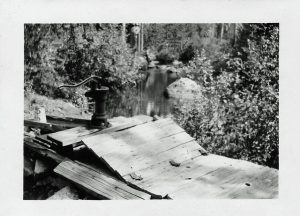
I last saw Robert and Eva in the summer of 1943 when I walked in from Tahoe. I ate so many of Evas pancakes that Robert said I must have a tape worm. A day or so later he drove me to Georgetown for an over night at his ranch. Breakfast was steak, potatoes and eggs. Wow! He put me on the bus home and I never saw him or Eva again. Damn!
Jerrett sold out sometime right after the end of WW II. Lon Chaney Jr. was the purchaser. I do not know that he ever actually visited Wentworth.”In fact, the MOUNTAIN DEMOCRAT announced by way of an article April 27, 1944, that Lon Chaney Jr and his wife had purchased the 1300 acre Robert S. Jerrert Ranch located in the Penoscot district. He also announced that he intended to rename the ranch La Cazador. In doing some research on the Chaney family, Lon Chaney Jr’s father’s passion was their mountain cabin on a lake in Southern California where they spent all of their spare time away from movie making fishing for trout on the lake. So I believe buying the Jerrett Ranch and Wentworth Springs was a natural thing for this actor who like his father had a great interest in the out of doors, the mountains and trout fishing.
In the words of Judge Wilbur Johnson………..”The Pic. No. 5 is a throw away. My dad and I, with mom, walked over to Mary’s Lake , close to Bixby, later made into part of Loon with the raising of the dam. (Bixby, not Mary’s) We made a raft of available flotsam; how we did it is altogether lost to me. I guess we were successful for we survived.
Richard Wentworth made his first trip to Wentworth Springs in 1951. He provides the following memory of that trip and many others over the next 25 years………Anyone who ever made a trip to anyplace along the Wentworth Springs Road from Riverton on Highway 50 before the current modern highway of the mid 1960s, remembers the difficulties and time necessary which Richard mentions in his memories below………Enjoy
“We were returning from Detroit with a new 1951 Olds that my father picked up at the factory. Dad saw the sign at Riverton that said Wentworth Springs Resort 30 miles. Mom said lets go and see, 30 miles isn’t that far. It took the rest of the day to get there. We spent 3 days that first trip, staying in the hotel on the second floor. We only had baby food for my sister, candy bars and other snacks were available at the hotel and dad caught fish. It was also fortunate that gasoline was available. The next year we stayed in a cabin and dad rode down to Rubicon Springs in that old jeep seen by the hotel . He brought back a LOT of fish and Wentworth Springs became our vacation place of choice. We were there every year until my fathers death in 75. My father became quite good friends with Orin Ellingson and helped him build the A frame that still stands today. I still have a letter signed by Orin giving dad permission to use the property.
I have many fond memories of the camp fire by the hotel and the stories Mr. Schuler, Mr. Vercamp and Mr. Wickander told. There was also an old gentleman that reminded me of Gaby Hays, I don’t remember his name, he played the guitar at the campfire as we all roasted marsh mellows. It was at that campfire that I kissed a girl for the first time.
Mr. Wickander gave my dog and I a ride to Buck Island once and I walked back to Wentworth. I was quite young at the time but since I had the dog with me mom thought it was OK.
One year some fellas came through on horse back to round up some cattle and they offered me a job. Mom said no because I would miss too much school.
We were at Buck Island one year when some sailors came through with a 49 Ford convertible. They had made a $30,000 bet with a casino that they could take it all the way through. They won, they were VERY big sailors and were able to do a lot of lifting.
Mom has found many arrow heads there and several sites where they may have been made.
I have found some rock carvings that I assume were made by the herders of the day. Over by the sweet water spring to the left of the hotel there are tree carvings but I imagine they are grown over by now.
I have seen pictures of Jack London at the mineral spring, and at the upper mineral spring there used to be game blinds built by the Indians of the area to ambush deer and other game.”
Richard Wentworth has kindly provided five pictures of Wentworth Springs from the Spring-Early Summer of 1963 after the failure of the coffer dam on Gerle Creek which was installed after the original 1882 Loon Lake Granite Block Dam was disassembled in October 1963 to make way for the construction of the current dam finished by Spring-Summer of 1964. This flooding of Wentworth Springs was a kind of demarcation point in it’s history. After the flooding damage, the owners were never able to recover back to their traditional resort offerings. Many of the wooden cabins were damaged and moved around. The store, gasoline sales, and hotel services were over. Even the old poker games which I remember seeing in the front part of the store were gone as well. I remember these events first hand as do a number of other Gerle Creek Tract Cabin Owners. Many thanks to Richard Wentworth for providing these historic pictures of Wentworth Springs, helping us document the history of this very key recreational element of the Georgetown Divide, El Dorado County and Eldorado National Forest.
1965-66 picture of Wentworth Springs taken by Gordon A. Brattland
Dr. Mark La Rue June 1, 2006

